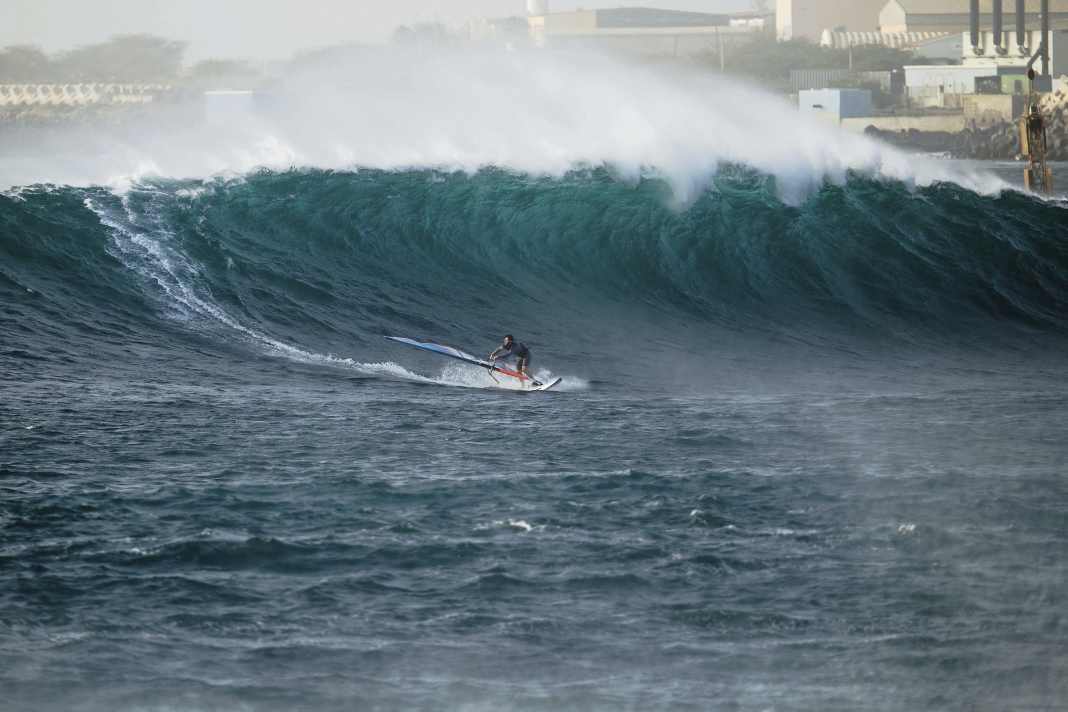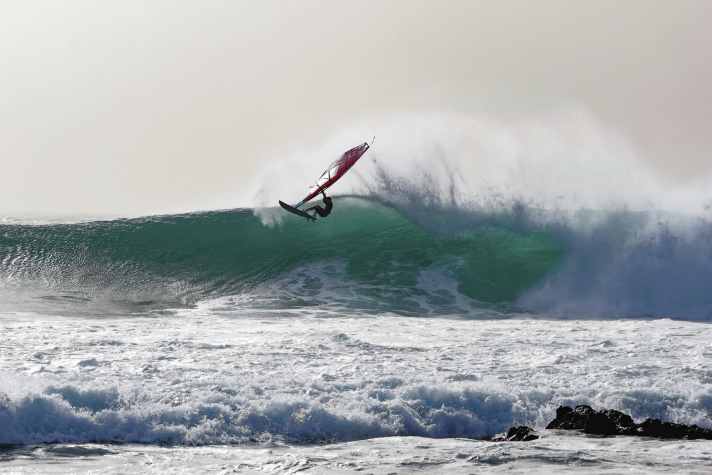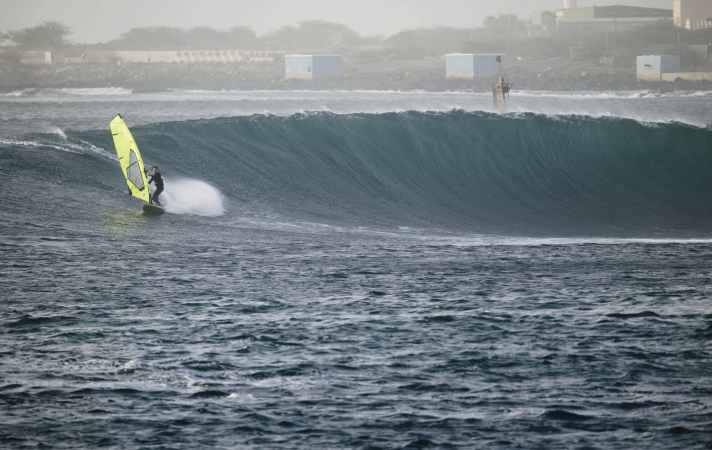Cape Verde Gallery: Leon Jamaer, Henri Kolberg and Laurin Schmuth on the swell of the year - the best pictures
Leon Jamaer
· 03.05.2025






The prediction
Leon: Sailors often make one last stop on the Cape Verde Islands before using the constant trade winds to cross the Atlantic on a cross-wind course. On the west coast of the island of Sal, this wind blows diagonally offshore. However, the world-class wave spots for which Sal is known need another component to come to life: a storm on the North Atlantic that does not discharge its energy somewhere between Iceland and Portugal as usual, but pushes the waves southwards. Only then will they reach the Cape Verde Islands, which lie far to the south between the 16th and 17th parallel. The forecast for the end of February left no doubt that all the prerequisites for epic conditions had been met.
Laurin: Cape Verde had been on my list for some time. Every winter you see pictures and videos of the spots and hear about how perfect it can be when the forecast is right. The clips from the film "Minds Wide Open" have also stuck with me since they were released 14 years ago.
Strike Mission Cape Verde
Henri: Laurin is less flexible in his dentistry studies than I am with my online degree programme. That's why we often only have the time in February and March to fly away for a few weeks outside of the World Cup season. Like last year, we kept an eye on the forecast for Tenerife, but unfortunately there wasn't much change. Then at some point Laurin sent us a message: "There's currently wind every day in Cape Verde and three swells are coming within a few days. Let's go!" At the time, we had no idea that this was one of the best forecasts in recent years. During the landing approach, we could already recognise the first spots and saw perfect waves breaking along the rocks. And this was despite the fact that the big swell hadn't even arrived yet. Our flight was through the night, so after landing we headed straight to Ponta Preta without any sleep. We had never seen anything like it. One perfect wave after another ran along the point. No matter which spot we went to in the following days, it was always so good that we had to go straight onto the water. We usually left the house early and came back four sessions later, only after sunset.
No matter which spot we went to, it was always so good that you had to go straight onto the water."
Leon: Although I had been keeping an eye on the weather maps for a few days, it all happened very quickly in the end. The parents-in-law stepped in to help with childcare, so I first went back from Lower Saxony to Preetz near Kiel, dropped off the postal voting documents at the office and picked up a new passport, then packed my things (4.5, 4.7, 5.0, an 87-litre board and a wave rider) and got back on the motorway to Düsseldorf. After a very short night in the car, I checked in and by midday Laurin and Henri, who had already been there for two days, greeted me at Sal airport. "You probably want to go to the flat first, don't you?" - "Erm, no, what are your plans?" - "Ali Baba." - "Yeah, okay."
Ali Baba - the longest wave
Laurin: And there we were. Ali Baba. The longest wave I've ever surfed. The wave rolls several hundred metres into the bay at extremely high speed. If you make a mistake, you end up on the razor-sharp rocks. The three of us learnt this the hard way, one after the other.
In technical jargon, such a wave is called a 'freight train'. Once you've jumped on the train, it's called 'pedal to the metal'."

Leon: The timeless shots at this spot by Kauli Seadi in "Minds Wide Open" are forever etched in my memory. In technical jargon, such a fast wave is called a "freight train". Jumping onto the trains rolling past at breakneck speed turned out to be not so easy. The wind is blowing almost completely offshore and the hills of the groundswell only pile up just in front of the rocks, so you can only use the momentum of the wave to glide on very late. What follows is a game of cat and mouse. You position yourself further and further inside and further upwind of the rocks so that the waves don't just pass underneath you. At the same time, you keep a close eye on the horizon so that you can get out of the way in time for larger sets that break further out. I remember a session in Ali Baba where I only caught two waves in two hours. Once you've jumped on the bandwagon, however, it's "pedal to the metal". The gusty wind quickly becomes powerful due to the wave and your own speed, and at critical moments it wants to rip the rig out of your hands. At the same time, the board continues to accelerate under your feet. The upper section of the wave can still be ridden relatively relaxed with carves, but further down you have to choose a highline like no other wave I know. The maximum speed of the equipment has been reached and you are stuck under the hollow breaking lip, using the thrust of the wave and the brutal wind shooting out of the wave to gain metres and make it to the car park section, which is then a little more relaxed again and allows further turns.
"Too good to be true" - and hefty wipeouts
Laurin: I got caught out once, freezing cold. I was too deep and realised that the wave was slowly closing. After just managing to get in front of the wave, I looked behind me and saw the lip, which was a little over a metre high, almost crashing down on me. I rode the white water for a few more metres before it swallowed me up. With a bit of luck and a fairly long swim, I managed to get myself washed ashore between two rocks. My equipment stayed intact and apart from a few cuts on my legs and feet, I was spared. I'll never forget some of the scenes that came to mind during this trip on the water. For example, Leon and I once took the second and third wave of a mast-high set. After a few turns, we pulled out and bobbed together back in the channel towards the point. Meanwhile, Henri came past us with an even bigger wave of the set and rode one turn after the other into the pocket of this perfect wave. It was sometimes too good to be true.
I rode a few more metres in the white water before it swallowed me up. A long swimming session followed."
The special kick at a spot in the north of Sal
Henri: One morning, when the wind was too offshore for the previous spots, but there was still plenty of swell on the way, we decided to explore a spot further north. The waves here come from the deep harbour basin of Sal, then really suck up and break on almost dry rocks. Fortunately, there is a large channel downwind through which you can ride out in a relaxed manner, but it's better not to crash on this wave. The spot pumped all the adrenalin into my body again towards the end of the trip. A container ship was moored a little further out. When it disappeared behind the waves, you knew the next set of monsters was rolling in. Hidden behind the first, slightly smaller wave was a wall of water that was well over a metre high. If you managed to pump yourself onto the wave, you had some time to position yourself and prepare for the ride. It's always a fine line to be deep enough to put the turn into the critical part of the wave, but not too deep that you get all the water on your head and end up on the rocks. Waiting for the wave to get steep, my knees start to shake. My pulse increases and my eyes look at the rocks I'm heading towards. When the moment arrives and the wave sucks itself up, everything becomes calm. I race down the wall of water to put all my weight on the rail at the foot of the wave. A few centimetres behind me, tonnes of water crash down. The wave thunders as if lightning is striking right next to me. After the session, I can't get the grin off my face. I keep asking myself how nature can create something so beautiful and crazy. The memories of this session and the whole trip will last forever!
When the container ship disappeared behind the waves, you knew that the next set of monsters was coming."

Material and trim
Leon: As soon as the wave period, the time interval between two waves, exceeds 15 seconds, a new dimension opens up for wave windsurfers. The waves travel faster and carry more energy due to the long, flat wave crest. As I hadn't surfed any real groundswell waves for over a year, it took some getting used to. I therefore switched to the thruster setup, which gave me a little more security, and moved both the base plate and fins forwards a little. This allows you to stand more above the board and utilise the entire rail line for your bottom and top turns, which also gives you more security. On the penultimate day, I felt confident enough to attack Ali Baba harder, and I finally managed a few airs where I positioned myself as late as possible under the lip and was then catapulted towards land with a huge impulse, landing in front of the wave and then making it around the section that was already breaking in front of me. I was able to share the pleasure of the waves of Sal day after day with Henri, Laurin and a few other windsurfers who had travelled here. Although my 4.7 sail, the size I used exclusively, and the rest of my equipment, apart from one mast, were still intact on the fifth day, I boarded the plane back to Germany completely empty-surfed and with no regrets.

